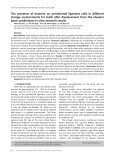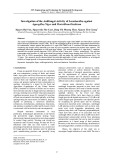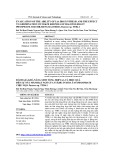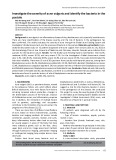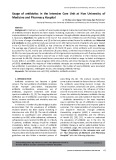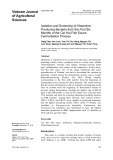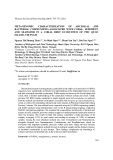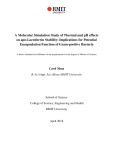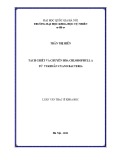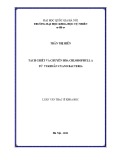Laccase-catalyzed polymerization of tyrosine-containing peptides Maija-Liisa Mattinen1, Kristiina Kruus1, Johanna Buchert1, Jacob H. Nielsen2, Henrik J. Andersen2 and Charlotte L. Steffensen2
1 VTT Biotechnology, Espoo, Finland 2 Danish Institute of Agricultural Sciences, Department of Food Science, Research Centre Foulum, Tjele, Denmark
Keywords cross-linking; ferulic acid; laccase; peptide; tyrosine
Correspondence M.-L. Mattinen, VTT Biotechnology, PO Box 1500, FIN-02044 VTT, Tietotie 2, Espoo, Finland Fax: +358 20 7227071 Tel: +358 20 7227143 E-mail: Maija.Mattinen@vtt.fi Website: http://www.vtt.fi/bel/
Laccase-catalyzed polymerization of tyrosine and tyrosine-containing pep- tides was studied in the presence and absence of ferulic acid (FA). Advanced spectroscopic methods such as MALDI-TOF MS, EPR, FTIR microscopy and HPLC-fluorescence, as well as more conventional analyt- ical tools: oxygen consumption measurements and SDS ⁄ PAGE were used in the reaction mechanism studies. Laccase was found to oxidize tyrosine and tyrosine-containing peptides, with consequent polymerization of the compounds. The covalent linkage connecting the compounds was found to be an ether bond. Only small amounts of dityrosine bonds were detected in the polymers. When FA was added to the reaction mixtures, it was found to be incorporated into the polymer structure. Thus, in addition to homo- polymers, different heteropolymers containing two or four FA residues were formed in the reactions.
(Received 15 March 2005, revised 18 May 2005, accepted 23 May 2005)
doi:10.1111/j.1742-4658.2005.04786.x
laccase-mediator system has been launched in the textile industry. The other applications, i.e., kraft pulp bleach- ing and detoxification have been only tested in labora- tory or pilot scale [19]. Interest in the use of laccases in food processing is also increasing [20–23]. Laccases have been tested in bread making, where they can improve bread volume [24]. They can cross-link pentosans and arabinoxylans via ferulic acid (FA) side-chains [25,26]. It has been suggested that this kind of cross-linking of feroylated carbohydrates by laccase is similar to the peroxidase-catalyzed reaction, the aromatic ring of FA being the initiating site for enzymatic oxidation [25].
Laccase (EC 1.10.3.2) is a multicopper enzyme belong- ing to the blue multicopper oxidase family. The most studied laccases are of fungal and plant origin [1–5], however, some bacterial laccases [6,7] have also been isolated. In addition, these enzymes have been found in some insects [8–10]. Laccases catalyze the oxidation of a wide range of organic and inorganic substances [11]. Typical organic substrates are aromatic compounds, such as different phenols, anilines and benzenethiols [11–17]. Laccases catalyze single-electron oxidation of the substrate, with concomitant reduction of molecular oxygen to water as shown in Scheme 1 [18]:
4Substrate (reduced) þ O2 þ 4Hþ þ 4e(cid:1)
laccase (cid:1)!
2H2O þ 4Substrate (oxidized)
Attempts to utilize the reactivity of laccase on phenolic substrates have been made, e.g., in pulp and paper, textile and food applications. Denim bleaching with a
It has also been shown that laccase can cross-link whey proteins in the presence of phenolic acid [27]. However, in order to be able to develop new applica- tions for laccases in foods, it is crucial also to under- stand enzymatic reactions on proteins at the molecular level. At present, laccase-catalyzed reactions resulting in oxidation of proteins are poorly understood. Very
FEBS Journal 272 (2005) 3640–3650 ª 2005 FEBS
3640
Abbreviations DP, degree of polymerization; FA, ferulic acid; GLY, glysine-leucine-tyrosine; GY, glysine-tyrosine; MNP, 2-methyl-2-nitrosopropane dimer; ThL, Trametes hirsuta laccase.
M.-L. Mattinen et al. ThL-catalyzed cross-linking of Y, GY, GLY and FA
the function of
little data is available for example on the efficiency of the enzymatic cross-linking and its effect on the func- tional properties of protein matrices [28,29]. The lack of systematic and comparative study with respect to both the protein substrate and the enzyme itself has limited understanding of laccases. Hitherto the only known chemical bond resulting from laccase-catalyzed oxidation of proteins is the disul- phide bond, and the oxidation of SH groups in pro- teins was found to be accelerated by addition of FA [30,31]. One of the difficulties involved in studies of laccase-catalyzed reactions is that the immediate prod- ucts are free radicals [32]. Radicals are extremely react- ive and may initiate various nonenzymatic reactions in reaction mixtures [33].
Fig. 1. Oxygen consumption vs time in ThL-catalyzed reactions on the model compounds (Y, GY, GLY and FA). The reference curve was measured from ThL solution without the substrate. Oxygen consumption curve (bold) for ThL treated Y in the presence of 0.15 mM FA is shown in the inset. The following reaction condi- tions were used: volume 1.84 mL, buffer 25 mM succinic acid pH 4.5, substrate concentration 1.5 mM and ThL dosage 100 nkatÆmL)1.
In this work modern spectroscopic techniques such as MALDI-TOF MS, EPR, FTIR microscopy and HPLC-fluorescence, as well as more conventional ana- lytical methods, such as oxygen consumption measure- ments and SDS ⁄ PAGE were used to analyze reaction mechanisms catalyzed by Trametes hirsuta laccase (ThL). Tyrosine (Y) and tyrosine-containing di- (gly- sine-tyrosine; GY) and tri-peptides (glysine-leucine- tyrosine; GLY) as well as FA were chosen as model substrates due to their phenolic structure.
Results
bonds between the monomers were expected to be formed by elimination of two hydrogen atoms. Thus, the predicted m ⁄ z-values for tyrosine and peptide poly- mers are given by Eqn (1):
Laccase-catalyzed oxidation of the model compounds
ð1Þ
½nMW (cid:1) ðn (cid:1) 1Þ2H þ H(cid:2)þ
where n is the number of monomers and MW is the molecular mass of the substrate.
Y, GY, GLY and FA were treated with ThL, and con- sumption of cosubstrate, oxygen, was monitored as a function of time (Fig. 1). Oxygen consumption rates were calculated from the linear slopes of the curves and the amounts of oxidized substrates were estimated from the curves after 5 min reaction times. For Y the oxygen consumption rate and the amount of oxidized substrate were 1.4 ± 0.04 · 10)12 molÆs)1Ænkat)1 and for GY 8.7 ± 0.3 · 10)12 molÆs)1Ænkat)1 and 11%, for GLY 3.8 ± 0.4 · 10)12 molÆs)1Ænkat)1 70%, and 30%, and for FA 14 ± 0.7 · 10)12 molÆs)1Ænkat)1 and 100%, respectively. Oxygen consumption rate was the highest for FA. The reactivity of Y alone was found to be 10-times lower than that of FA. GY and GLY peptides were better substrates for ThL than the single amino acid Y.
Laccase-catalyzed polymerization of tyrosine and tyrosine-containing peptides
MALDI-TOF mass spectra of Y and GY after ThL treatment are shown in Fig. 2A,B. Clear cross-linking of the model compounds was observed. For Y and GY homopolymers up to 9 and 8 units, respectively, could be detected from the reaction mixture in less than 2 h. After 24 h hardly any of the cross-linked end-products nor low molecular mass components could be detected from the solution (data not shown) indicating extensive polymerization of the model com- pounds. For GLY similar mass spectra were measured (data not shown), but because of the higher molecular mass of GLY only polymers up to 5 units could be identified from the spectra. The m ⁄ z values of the main polymerization products with the corresponding theor- etical values are listed in Table 1. Several control sam- ples showed that no self-polymerization of Y or of peptides occurred without ThL. Thus, the Y and pep- tide polymers identified from the mass spectra resulted solely from the ThL-catalyzed reactions.
MALDI-TOF MS was used to analyze the reaction end- products in laccase catalyzed reactions. The covalent
FEBS Journal 272 (2005) 3640–3650 ª 2005 FEBS
3641
M.-L. Mattinen et al. ThL-catalyzed cross-linking of Y, GY, GLY and FA
A
the m ⁄ z values of the homopolymers Table 1. Assignment of resulting from incubation of Y, GY and GLY with ThL. The corres- ponding MALDI-TOF mass spectra of Y and GY are shown in Fig. 2. The predicted m ⁄ z values of the homopolymers are shown for comparison.
Compound Observed mass (m ⁄ z) Predicted mass (m ⁄ z)
B
718.98 897.98 1076.90 1255.90 1434.90 1614.80 711.14 947.24 1183.30 1419.40 1655.50 1891.60 701.31 1050.50 1399.50 1748.70 719.30 898.37 1077.44 1256.52 1435.59 1614.67 711.29 947.38 1183.48 1419.57 1655.67 1891.76 701.36 1050.54 1399.72 1748.90 [Y4H]+ [Y5H]+ [Y6H]+ [Y7H]+ [Y8H]+ [Y9H]+ [(GY)3H]+ [(GY)4H]+ [(GY)5H]+ [GY)6H]+ [(GY)7H]+ [(GY)8H]+ [(GLY)2H]+ [GLY)3H]+ [GLY)4H]+ [(GLY)5H]+
C
(Fig. 3). For GY the molecular mass distribution of the polymers was found to be (cid:3) 3–14 kDa (gel B, lines 1 and 2), for GLY (cid:3) 5–14 kDa (gel B, lines 5 and 6) and for Y even longer polymers (cid:3) 6–17 kDa (gel A, lines 1 and 2) could be identified from the gels. Thus, the DP varied from 13 to 59 for GY, from 14 to 40 for GLY and from 33 to 94 for Y. The control sam- ples were also analyzed and neither large protein impurities nor Y and peptide self-polymerization were detected (data not shown).
The radicals
Fig. 2. Positive MALDI-TOF mass spectra measured from ThL-trea- ted Y and GY. (A) Y, (B) GY and (C) GY in the presence FA. The numbers of monomers (n) in Y and GY homopolymers are shown above the peaks in the spectra. The positions of the peaks for GY heteropolymers are shown by lines below the spectra. The follow- ing reaction conditions were used: volume 0.5 mL, buffer 25 mM succinic acid pH 4.5, substrate concentration 1.5 mM for Y and 3 mM for GY and FA, ThL dosage 100 nkatÆmL)1 and reaction time (cid:3) 2 h.
SDS ⁄ PAGE analyses of the reaction end-products were carried out in order to estimate the molecular i.e., the mass distributions of the reaction products, degree of polymerization (DP) of Y, GY and GLY homopolymers, identified from the MALDI-TOF mass spectra (Fig. 2) after overnight ThL treatment. The lines for ThL-treated Y and peptides were very hetero- geneous, showing that mixtures of polymers with dif- ferent molecular masses were formed in the reactions
formed in ThL-catalyzed reactions were spin-trapped by 2-methyl-2-nitrosopropane dimer (MNP) and subsequently analyzed by EPR. When unlabelled substrates were used in the reactions, it was impossible to conclude whether the radicals were formed in the tyrosine ring, or in the backbone of the peptides. An ambiguity exists in the EPR signal, as it can be simulated in two ways, of which the first is con- sistent with a MNP spin-trapped radical positioned in the tyrosyl ring, and coupling to two times two equiv- alent hydrogen atoms. The second simulation is consis- tent with a MNP spin-trapped carbon-centred radical positioned close to the backbone nitrogen and two equivalent hydrogen atoms. The resulting identical simulation of the EPR signal is shown in Fig. 4B. In order to solve this problem [15N]Y was selected as a model compound in addition to Y, GY and GLY. Any radical that is coupled to the 15N-labelled nitro- gen will exhibit a completely different pattern in the
FEBS Journal 272 (2005) 3640–3650 ª 2005 FEBS
3642
M.-L. Mattinen et al. ThL-catalyzed cross-linking of Y, GY, GLY and FA
A
B
Fig. 3. SDS ⁄ PAGE analysis of ThL-treated Y, GY and GLY in the presence and absence of FA. Substrate and FA concentrations used in the reactions are shown in the tables below the corresponding gel. Otherwise the following reaction conditions were utilized: volume 0.5 mL, buffer 25 mM succinic acid pH 4.5, ThL dosage 100 nkatÆmL)1 and reaction time (cid:3) 24 h. Two markers (MW: 1.4, 3.5, 6.5, 14, 17, 27 kDa and MW: 6.5, 14, 20, 24, 29, 36, 45, 66 kDa) were used for molecular mass estimations.
EPR spectrum compared to the spectrum measured from the unlabelled compound. The simulated EPR spectra of backbone and tyrosyl radicals for [15N]Y are shown for comparison in Fig. 4A and B, respect- ively.
radicals
The experimental EPR spectra of ThL-generated radicals on [15N]Y, Y and GY are shown in Fig. 4C, D and E, respectively. The patterns of experimental EPR spectra of [15N]Y, Y and GY were identical and typical for peptide radicals. A similar 13-line EPR spectrum was obtained from ThL-treated GLY (data
not shown). Because the experimental EPR spectrum of [15N]Y was found to be identical to the simulated EPR spectrum, in which the radical is in the aromatic ring (Fig. 4B,C), ThL-generated radicals on model compounds were identified as tyrosyl radicals. Simula- tions of the experimental EPR spectra of [15N]Y, Y, GY and GLY yielded hyperfine coupling constants for backbone and tyrosyl that are listed in Table 2. The values determined for Y, GY and GLY are very similar confirming that identical radicals are formed in these substrates after ThL treatment. The
FEBS Journal 272 (2005) 3640–3650 ª 2005 FEBS
3643
M.-L. Mattinen et al. ThL-catalyzed cross-linking of Y, GY, GLY and FA
A
Table 2. Hyperfine coupling constants of nitrogens (aN) and hydro- gens (aH and 2aH) determined from the simulated EPR spectra of [15N]Y, Y, GY, GLY and FA. The simulations were performed in two different ways, i.e., assuming the presence of tyrosyl and backbone radicals. The corresponding experimental EPR spectra of [15N]Y, Y, GY and FA are shown in Fig. 4.
B
Coupling constants
aN for MNP (G) aN for amide (G) aH (G) Substrate 2aH (G) 2aH (G)
[15N]Y 2.44 3.54
C
Y 2.49 2.48 GY 2.44 2.49 GLY 2.39 Tyrosyl backbone Tyrosyl backbone Tyrosyl backbone Tyrosyl backbone 2.49 2.48 2.46 2.49 2.46 2.49 2.42 2.49 2.39
D
10.28 10.28 10.28 10.30 10.36 10.36 10.31 10.31 15.84 2.55 FA
E
F
FTIR spectra measured from the pure substrates (Fig. 5A,D) with the spectra measured from laccase- treated Y and GY (Fig. 5B,E) revealed that the band for the hydroxyl group of tyrosine at about 1250 cm)1 (phenolic C–OH stretching vibration typically located around 1180–1260 cm)1) had almost disappeared and a new strong ether band around 1130 cm)1 (C–O–C stretching vibration typically located around 1010– 1270 cm)1) had been formed. At the same time the intensity of the band of 1,4-disubstituted aromatic ring around 1515 cm)1 (C–C stretching vibration typically located around 1450 cm)1 and 1512 cm)1) decreased. These results indicated that ThL-treated Y and GY polymerize through a tyrosine ring and that the cova- lent bond between the monomers is an ether bond (isodityrosine bond). Similar spectral changes were obtained for ThL-treated GLY (data not shown).
Fig. 4. EPR spectra measured from ThL-treated Y, GY and FA. In the upper part of the figure are shown for comparison the simula- ted EPR spectra of [15N]Y, when radicals are located in the back- bone (A) and in the aromatic ring (B) of the substrate. The experimental EPR spectra of ThL-treated [15N]Y (C), Y (D), GY (E) and FA (F) are shown below the simulated spectra. The following reaction conditions were used: volume 0.5 mL, buffer 25 mM MNP solution made in 25 mM succinic acid pH 4.5, substrate concentra- tion 1.5 mM for labelled and unlabelled tyrosine and 3 mM for GY and FA, ThL dosage 100 nkatÆmL)1 and reaction time (cid:3) 0.5 h.
In addition to isodityrosine bonds, dityrosine bonds can be expected to form in ThL-catalyzed reactions on model substrates. These bonds are difficult to visualize by FTIR and thus the amounts of dityrosine bonds formed in the reaction mixtures were analyzed by HPLC fluorescence. The results (Table 3) showed that only small amounts of dityrosine bonds were formed in the reactions. No dityrosine bonds were observed in the control samples prepared without ThL (data not shown).
aN coupling constant for amide nitrogen of [15N]Y backbone radical differs from the other corresponding values because of labelled nitrogen in the backbone.
Effect of FA on ThL-catalyzed polymerization of tyrosine and tyrosine-containing peptides
MALDI-TOF mass spectra were also measured from ThL-treated Y and peptide reaction mixtures in the
FTIR microscopy was used to analyze the types of chemical bonds formed in the ThL-catalyzed reactions on Y and model peptides. Parallel interpretation of the
FEBS Journal 272 (2005) 3640–3650 ª 2005 FEBS
3644
M.-L. Mattinen et al. ThL-catalyzed cross-linking of Y, GY, GLY and FA
A
B
C
D
E
F
G
H
Fig. 5. FTIR microscope spectra measured from ThL-treated Y and GY and in the pres- ence and absence of FA. The reference spectra measured from (A) Y, (D) GY and (G) FA are shown above the spectra meas- ured from ThL-treated model compounds (B) Y, (E) GY and (H) FA. The spectra meas- ured from ThL-treated Y and GY in the presence of FA are shown in (C) and (F), respectively. The following reaction condi- tions were used: volume 0.5 mL, solvent distilled water pH 4.5, substrate concentra- tion 1.5 mM for Y and 3 mM for GY and FA, ThL dosage 100 nkatÆmL)1 and reaction time (cid:3) 2 h. The lines above the spectra are guides for the eye.
Table 3. Dityrosine formation in ThL-catalyzed reactions on Y, GY and GLY from originally available tyrosine of the substrate in the presence and absence of FA. The following reaction conditions were used: volume 100 lL, substrate concentration 1.5 mM for Y, 3 mM for GY and GLY, and 0.3 and 3 mM for FA, buffer 25 mM suc- cinic acid pH 4.5, ThL dosage 100 nkatÆmL)1 and reaction times (cid:3) 0.5 h, 2 h and 24 h.
Average amount of dityrosine formed from tyrosine of the substrate
In buffer (%) In buffered 0.3 mM FA (%) In buffered 3 mM FA (%) Substrate
0.7 ± 0.03 0.5 ± 0.02 0.6 ± 0.02 0 0.8 ± 0.02 0.6 ± 0.03 0.7 ± 0.08 0 0.9 ± 0.2 0.8 ± 0.05 0.9 ± 0.08 0 Y GY GLY None
presence of FA. Addition of FA into the ThL and Y reaction mixture in equivalent molar concentration with the substrate did not markedly affect the chemical composition of the Y polymers. Homopolymers up to 9 units as in the case of pure substrate were easily identified from the mass spectra and only trace amounts of heteropolymers containing FA could be detected from the mass spectra above the noise level (data not shown). However, in the case of peptide sub- strates the number of polymers increased when FA was added into the reaction mixture in molar ratios of 1 : 1 or 1 : 10 with the substrate. In addition to the peptide homopolymers, at least two different series of heropolymers were identified from the mass spectra. For GY on the basis of m ⁄ z values they were
FEBS Journal 272 (2005) 3640–3650 ª 2005 FEBS
3645
M.-L. Mattinen et al. ThL-catalyzed cross-linking of Y, GY, GLY and FA
Table 4. Assignment of the m ⁄ z values of the heteropolymers resulting from incubation of Y, GY and GLY in FA solution with ThL. The corresponding MALDI-TOF mass spectrum measured from ThL-treated GY in the presence of FA is shown in Fig. 2. The pre- dicted m ⁄ z values of the heteropolymers are shown for compar- ison.
Compound Observed mass (m ⁄ z) Predicted mass (m ⁄ z)
than the substrate concentration. On the basis of the EPR spectra (data not shown), addition of FA to the reaction mixture decreased the concentrations of Y and peptide radicals significantly and FA radicals were primarily produced in ThL-catalyzed reactions. In the reference sample, i.e., in the reaction mixture without substrate, oxidation of FA with ThL was so rapid that only a signal from the radical formed in the carbon to hydrogen could be detected by EPR adjacent (Fig. 4F). Simulation of this EPR spectrum yielded the hyperfine coupling constants listed in Table 2. Coup- ling constant aN of MNP is nearly the same as deter- mined for pure MNP (aN (cid:3) 15.4 G). On the basis of this experimental data it was impossible to identify the position of the carbon radical.
859.20 1095.30 1331.40 1567.40 1803.60 1007.20 1243.30 1479.40 1715.50 736.22 1085.50 1434.60 1783.80 1120.40 1469.50 1818.80 859.31 1095.40 1331.50 1567.59 1803.69 1007.33 1243.42 1479.52 1715.61 736.30 1085.47 1434.65 1783.83 1120.41 1469.59 1818.77 [FA2(GY)2H]+ [FA2(GY)3H]+ [FA2(GY)4H]+ [FA2(GY)5H]+ [FA2(GY)6H]+ [FA4GYH]+ [FA4(GY)2H]+ [FA4(GY)3H]+ [FA4(GY)4H]+ [FA2GLYH]+ [FA2(GLY)2H]+ [FA2(GLY)3H]+ [FA2(GLY)4H]+ [FA4GLYH]+ [FA4(GLY)2H]+ [FA4(GLY)3H]+
i.e.,
FTIR microscopy spectra measured from ThL-trea- ted Y and GY in the presence of FA in equivalent molar ratio with substrate are shown in Fig. 5C and F, respectively. In addition to the above described spectral changes observed with ThL-treated Y and peptide substrates, a weak carbonyl band of the ester bond around 1770 cm)1 (C¼O stretching vibraton typ- ically located 1700–1800 cm)1) appeared in the spectra. The same band was also observed in the FTIR spec- trum of ThL-treated GLY in the presence of FA (data in the not shown). In the reference spectrum, FTIR spectrum of ThL-treated FA (Fig. 5H), a similar carbonyl band typical for ester bonds was observed. However, on the basis of the FTIR spectra measured from the ThL-treated substrates in the presence of FA, it was impossible to conclude whether the ester bond was caused by dimerization of FA alone or by FA cross-linking to Y and peptide substrates.
FA2(GY)n+1 and FA4(GY)n polymers, where n is 1, 2, 3… as shown in Fig. 2C. Similar series of hetero- polymers were identified from the mass spectra of GLY (data not shown). The cross-links between FA and peptides were formed by elimination of two hydrogen atoms. The observed experimental and corresponding theoretical m ⁄ z values of the hetero- polymers are listed in Table 4. The control samples prepared without ThL showed that there was no tyrosine or peptide self-polymerization in the presence of FA, proving that the heteropolymers identified from the mass spectra resulted solely from the ThL-catalyzed reactions.
The amounts of dityrosine bonds formed in ThL- catalyzed reactions on Y and peptide substrates in the presence of FA were also analyzed by HPLC-fluores- cence. The results (Table 3) showed that in the pres- ence of FA only a slightly higher amount of dityrosine was formed compared to the reactions performed in pure substrate solutions with ThL. Increase in FA con- centration did not significantly affect the formation of dityrosine.
Discussion
Reaction mixtures containing substrate and ThL precipitated within a few hours in the presence of FA. Therefore the samples for SDS ⁄ PAGE analyses were taken from both the solid and liquid phase of the reac- tion mixture. The results (Fig. 3A, lines 3, 4 and Fig. 3B, lines 3, 4, 7, 8) showed that addition of FA did not affect the molecular mass distribution of the homo- and heteropolymers formed in the reaction mixture as compared to the homopolymers formed without FA. Cross-linking of FA into the peptide homopolymers had an effect on the solubility of the reaction end-products.
The aim of the present investigation was to elucidate the ThL-catalyzed reaction mechanism on protein mat- rix using Y, GY and GLY and FA as model com- pounds. Intermediate radicals that can be assumed to occur in ThL-catalyzed reactions on tyrosine and tyro- shown in Scheme 2 sine-containing peptides are [34,35]:
ThL-generated radicals on Y and peptides were also measured by EPR in the presence of FA. In these experiments the FA concentration was 10-times lower
FEBS Journal 272 (2005) 3640–3650 ª 2005 FEBS
3646
M.-L. Mattinen et al. ThL-catalyzed cross-linking of Y, GY, GLY and FA
carbon-centered radicals [36]. Different spin stabiliza- tion methods such as 5,5-dimethylpyrroline-N-oxide [37] and Zn buffer [38] were also tested (data not shown) in order to observe phenoxyl and oxygen radi- cals as well as semiquinones. However, neither of these techniques provided any evidence for reduced oxygen species.
ThL-catalyzed oxidation of FA and the formation are presented in Scheme 3
radicals
intermediate [32,35]:
The FTIR spectra showed that ether bonds were formed in the reactions, indicating that phenoxyl radi- cals must occur in ThL-catalyzed reactions on the selected model compounds. Isodityrosine bonds were formed when hydroxyl and tyrosyl radicals located in different molecules reacted with each other (Scheme 2). When the reaction cycle was repeated several times, long tyrosine and peptide polymers were formed in the reaction mixture. HPLC fluorescence measurements supported this reaction mechanism, because only a small amount of dityrosine was formed in the reac- tions.
transfer
radical
The ability of laccases to cross-link large proteins still remains to be studied. On the basis of our earlier studies with proteins it was concluded that a suitable small molecule mediator is necessary for protein cross- linking with laccase [39]. However, the data presented in this work showed that a small molecule mediator, for example FA, is not necessary for polymerization of Y and short peptides with ThL. When small mole- cules, which are easily oxidized by ThL and capable of reactions, are added to the enzyme–protein reaction mixtures, the accessibility of reactive amino acid side-chains for radical formation is enhanced, resulting in extensive cross-linking of the substrate. When large proteins containing hundreds of amino acids are used as substrates, the accessibility of tyrosine may be limited and hence the extent of cross- linking is low without a phenolic acid.
On the basis of the experimental data presented in this work, ThL-catalyzed oxidation of tyrosine and tyrosine-containing peptides is proposed to proceed in the following way. Enzymatically generated radicals are first formed in the hydroxyl group of the phenolic ring and then rapidly delocalize into the different posi- tions of the aromatic ring. Tyrosyl radicals could be detected by EPR using the MNP spin-trapping tech- nique, as this method is well established for stabilizing
In the case of tyrosine and peptide substrates the role of FA in the ThL-catalyzed reactions is rather complex because the enzyme oxidizes FA and peptide substrates simultaneously. Furthermore, several non- enzymatic reactions may take place in the reaction mixtures at the same time. Enzymatically and non- enzymatically generated radicals can further react with each other in many ways and thus the number of possible reaction products is huge [32,34,35]. For example it is also possible that FA monomers are first dimerized and then enzymatically linked into the pep- tide polymers. From the MALDI-TOF mass spectra two different series of peptide heteropolymers could easily be identified. Corresponding peptide polymeriza- tion reactions have been observed in peroxidase-cata- lyzed reactions on model peptides in the presence of FA [40–42].
FEBS Journal 272 (2005) 3640–3650 ª 2005 FEBS
3647
USA) and subsequent staining with Coomassie Brilliant Blue according to Laemmli [45]. Molecular mass standards 1.4–27 kDa (Bio-Rad, Hercules, CA, USA) for peptides and 6.5–66 kDa (Sigma) for proteins were used in the molecular mass estimations.
M.-L. Mattinen et al. ThL-catalyzed cross-linking of Y, GY, GLY and FA
EPR measurements
It can be concluded on the basis of the results pre- sented in this work that Y, GY, GLY and FA are substrates for ThL. When tyrosine and tyrosine-con- taining peptides were oxidized by ThL in the presence of FA, FA could be linked into the polymer structure. However, it is still unclear where in the aromatic ring the covalent bonds between the monomers are formed. Thus, the reaction mechanism studies will be continued using proteins and different phenolic acids as model compounds.
Experimental procedures
Materials
Radical formation in ThL-catalyzed reactions was analyzed using an EPR spectrometer (Bruker EMX X-band EPR spectrometer equipped with an ER4119HS cavity, Rhein- stetten, Germany). Magnetic field was modulated with 100 kHz frequency using 2 G field modulation amplitude. Receiver gain was 2 · 106, sweep time was 655 s and the time constant was 336 ms. Microwave power was con- stantly 63 mW. Hyperfine coupling constants were meas- ured directly from the field scan, optimized by niehs p.e.s.t. winsim simulation software (winsim, available at http://epr.niehs.nih.gov/) and the final EPR spectra simula- tion was done by Bruker simfonia version 1.25 simulation software. Correlation coefficients between simulated and experimental spectra were over 0.90.
Mass spectrometry analysis
Amino acids, Y and [15N]Y, and peptides, GY and GLY, were all purchased from Sigma-Aldrich (St Louis, MO, USA). Ferulic acid was obtained from Fluka (Buchs, Switzerland). Trametes hirsuta laccase was purified at VTT Biotechnology and was used in all reactions [43]. Enzyme activity was determined according to Niku-Paavola et al. using 2,2¢-azino-bis(3-ethylbenzthiazoline-6-sulfonic acid) as substrate [44]. Enzymatic reactions were carried out in 25 mm succinic acid (Merck, Darmstadt, Germany), pH 4.5 at 25 (cid:1)C with an enzyme dosage of 100 nkatÆmL)1, which corresponded to approximately 0.6 lm laccase concentra- tion. The concentrations of the model substrates varied between 0.1 and 12 mm in different experiments, with incu- bation times of 0.5–24 h.
EPR measurements were performed in buffered 25 mm solution. The
(MNP)
2-methyl-2-nitrosopropane dimer spin-trap was purchased from Sigma-Aldrich.
For FTIR microscope measurements, the reactions were carried out in distilled water and the pH of the solution was adjusted to 4.5 with dilute hydrochloric acid.
Mass spectra of the reaction products were measured by a Bruker Reflex MALDI-TOF MS (Bremen, Germany) equipped with a 337 nm nitrogen laser. The ion acceleration voltage was 20 kV. External mass calibration was performed using peptide calibration standard (Bruker Daltonics GmbH, Bremen, Germany). A small aliquot (1 lL) of the reaction mixture was applied on the sample target plate, mixed with 0.1% (v ⁄ v) trifluoroacetic acid and matrix solu- tion [15–20 gÆL)1 of a-cyano-4-hydroxycinnamic acid in 70% (v ⁄ v) acetonitrile] and allowed to dry at room temperature. Typically 50–100 scans were averaged to obtain the spec- trum.
Oxygen consumption measurements
FTIR measurements
The reactivity of ThL with Y, GY, GLY and FA was measured by following the consumption of dissolved oxy- gen during the enzymatic reaction. After initiation of the reaction by addition of the enzyme, oxygen consumption was monitored for 2 h using an oxygen electrode (FIBOX 3 fiber-optic oxygen meter, PreSens, Regensburg, Germany). The measurements were carried out under constant agita- tion in 2 mL volume in fully sealed flasks to avoid entry of oxygen into the reaction mixture.
The types of chemical bonds between the peptide mono- mers were analyzed using a Bruker Equinox 55 Irscope FTIR Microscope (Karlsruhe, Germany). For the analysis, 1–10 lL of the reaction mixture was applied on the gilded sample plate and dried at room temperature. FTIR spectra of the polymerization products were measured using the reflection technique. The size of the measuring area was typically 200 · 400 lm2. The spectral resolution was 4 cm)1 and the number of scans was 200.
SDS/PAGE electrophoresis
HPLC analysis of dityrosine
Aliquots (100 lL) of the reaction mixtures were hydrolyzed overnight at 105 (cid:1)C in 6 m HCl [46]. After hydrolysis the
The molecular mass distributions of the polypeptides formed in the ThL-catalyzed reactions after 24 h incubation were analyzed by SDS ⁄ PAGE electrophoresis (16.5% Tris ⁄ tricine polyacrylamine gel, Bio-Rad, Hercules, CA,
FEBS Journal 272 (2005) 3640–3650 ª 2005 FEBS
3648
10 Kramer KJ, Kanost MR, Hopkins TL, Jing H, Zhu YC, Xu R, Kerwin JL & Turecek F (2001) Oxidative conjugation of catechols with proteins in insect skeletal systems. Tetrahedron 57, 385–392.
11 Xu F (1996) Oxidation of phenols, anilines, and benzen- ethiols by fungal laccases: correlation between activity and redox potentials as well as halide inhibition. Biochemistry 35, 7608–7614.
12 Ikeda R, Sugihara J, Uyama H & Kobayashi S (1996)
samples were neutralized with 6 m NaOH and 20 lL of the hydrolyzed sample was injected into an HPLC column (Microsorb 100-5 C-18, 250 · 4.6, Varian, Walnut Creek, CA, USA), which was equilibrated with 4% (v ⁄ v) acetonit- rile in aqueous 0.10 m citric acid, pH 2.6, with a flow rate of 1 mLÆmin)1. Chromatographic separation was performed with a Varian HPLC system with a fluorescence detector (excitation at 283 nm and emission at 410 nm). The amount of dityrosine was calculated using an external standard calibration curve [47].
Enzymatic oxidative polymerization of 2,6-dimethylphe- nol. Macromolecules 29, 8702–8705.
13 Thurston CF (1994) The structure and function of fun-
M.-L. Mattinen et al. ThL-catalyzed cross-linking of Y, GY, GLY and FA
Acknowledgements
gal laccases. Microbiology 140, 19–26.
14 Ikeda R, Uyama H & Kobayashi S (1996) Novel syn- thetic pathway to a poly(phenylene oxide). Laccase- catalyzed oxidative polymerization of syringic acid. Macromolecules 29, 3053–3054.
15 Xu F, Shin W, Brown SH, Wahleithner JA, Sundaram
This study has been carried out with financial support from the Commission of the European Communities, specific RTD programme ‘Quality of Life and Man- agement of Living Resources’, proposal number QLK1-2002-02208 ‘Novel crosslinking enzymes and their consumer acceptance for structure engineering of foods’ (CROSSENZ). It does not reflect its views and in no way anticipates the Commissons’s future policy in this area.
UM & Solomon EI (1996) A study of a series of recom- binant fungal laccases and bilirubin oxidase that exhibit significant differences in redox potential, substrate speci- ficity, and stability. Biochim Biophys Acta 1292, 303–311.
References
16 Bollag JM, Sjoblad RD & Minard RD (1977) Polymeri- zation of phenolic intermediates of pesticides by a fun- gal enzyme. Experientia 33, 1564–1566.
1 Harvey BM & Walker JRK (1999) Studies with plant laccases. I. Comparison of plant and fungal laccases. Biochem Mol Biol Biophys 3, 45–51.
17 Bollag JM, Minard RD & Liu SY (1983) Cross-linkage between anilines and phenolic humus constituents. Environ Sci Technol 17, 72–80.
18 Yaropolov AI, Skorobogatko OV, Vartanov SS &
2 Solomon EI, Sundaram UM & Machonkin TE (1996) Multicopper oxidases and oxygenases. Chem Rev 96, 2563–2605.
3 Mayer AM & Harel E (1979) Polyphenol oxidases in
Varfolomeyev SD (1994) Laccase. Properties, catalytic mechanism and applicability. Appl Biochem Biotechnol 49, 257–280.
plants. Phytochemistry 18, 193–215.
4 Huttermann A, Mai C & Kharazipour A (2001) Modi-
19 Xu F (1999) Fermentation, biocatalysis and biosepara- tion. In The Encyclopedia of Bioprocessing Technology (Flickinger MC & Drew SW, eds), pp. 1545–1554. John Wiley & Sons, New York.
fication of lignin for the production of new com- pounded materials. Appl Microbiol Biotechnol 55, 387–394.
5 Sato Y, Wuli B, Sederoff R & Whetten R (2001)
20 Gianfreda L, Xu F & Bollag J-M (1999) Laccases: a use- ful group of oxidoreductive enzymes. Biorem J 3, 1–26. 21 Minussi RC, Pastore GM & Duran N (2002) Potential
applications of laccase in the food industry. Trends Food Sci Technol 13, 205–216.
22 Labat E, Morel MH & Rouau X (2001) Effect of lac-
Molecular cloning and expression of eight cDNAs in loblolly pine (Pinus taeda). J Plant Res 114, 147–155. 6 Claus H & Filip Z (1997) The evidence for a laccase-like enzyme activity in a Bacillus sphaericus strain. Microbiol Res 152, 209–216.
7 Givaudan A, Effosse A, Faure D, Potier P, Bouillant ML
case and manganese peroxidase on wheat gluten and pentosans during mixing. Food Hydrocoll 15, 47–52. 23 Micard V & Thibault J-F (1999) Oxidative gelation of
& Bally R (1993) Polyphenol oxidase in Azospirillum lipoferum isolated from rice rhizosphere: evidence for laccase activity in non-motile strains of Azospirillum lipoferum. FEMS Microbiol Lett 108, 205–210.
sugar-beet pectins: use of laccases and hydration proper- ties of the cross-linked pectins. Carbohydrate Polymers 39, 265–273.
24 Si JQ (1994) Use of Laccases in Baking. Patent No.
WO94 ⁄ 28728.
8 Diamantidis G, Effosse A, Potier P & Bally R (2001) Purification and characterization of the first bacterial laccase in the rhizospheric bacterium Azospirillum lipo- ferum. Soil Biol Biochem 32, 919–927.
9 Hopkins TL & Kramer KJ (1992) Insect cuticle scleroti-
25 Figueroa-Espinoza MC & Rouau X (1998) Oxidative cross-linking of pentosans by a fungal laccase and horseradish peroxidase: mechanism of linkage
zation. Annu Rev Entomol 37, 273–302.
FEBS Journal 272 (2005) 3640–3650 ª 2005 FEBS
3649
37 Pou S, Hassett DJ, Britigan BE, Cohen MS & Rosen
between feruloylated arabinoxylans. Cereal Chem 75, 259–265.
GM (1989) Problems associated with spin trapping oxy- gen-centered free radicals in biological systems. Anal Biochem 177, 1–6.
38 Kalyanaraman B, Sealy RC & Sivarajah K (1984) An
26 Figueroa-Espinoza MC, Morel MH, Surget A & Rouau X (1999) Oxidative cross-linking of wheat arabinoxylans by manganese peroxidase. Comparison with laccase and horseradish peroxidase. Effect of cysteine and tyrosine on gelation. J Sci Food Agric 79, 460–463.
electron spin resonance study of o-semiquinones formed during the enzymatic and autoxidation of catechol estrogens. J Biol Chem 259, 14018–14022.
27 Færgemand M, Otte J & Qvist KB (1998) Cross-linking of whey proteins by enzymatic oxidation. J Agric Food Chem 46, 1326–1333.
39 Lantto R, Scho¨ nberg C & Buchert J (2004) Effects of laccase-mediator combinations on wool. Textile Res J 74, 713–717.
40 Uyama H, Maruichi N, Tonami H & Kobayashi S
(2002) Peroxidase-catalyzed oxidative polymerization of bisphenols. Biomacromolecules 3, 187–193.
28 Figueroa-Espinoza M-C, Morel M-H, Surget A, Asther M, Moukha S, Sigoillot J-C & Rouau X (1999) Attempt to cross-link feruloylated arabinoxylans and proteins with a fungal laccase. Food Hydrocoll 13, 65–71. 29 Shotaro Y (1999) Method for Cross-linking Protein by
41 Oudgenoeg G, Hilhorst R, Piersma SR, Borieu CG,
Using Enzyme. US Patent 6,121,013.
Gruppen H, Hessing M, Voragen AGJ & Laane C (2001) Peroxidase-mediated cross-linking of a tyrosine- containing peptide with ferulic acid. J Agric Food Chem 49, 2503–2510.
42 Oudgenoeg G, Dirksen E, Ingemann S, Hilhorst R,
30 Figueroa-Espinoza M-C, Morel M-H & Rouau X (1998) Effect of lysine, tyrosine, cysteine, and glu- tathione on the oxidative cross-linking of feruloylated arabinoxylans by a fungal laccase. J Agric Food Chem 46, 2583–2589.
31 Labat E, Morel MH & Rouau X (2000) Effects of lac- case and ferulic acid on wheat flour doughs. Cereal Chem 77, 823–828.
Gruppen H, Boeriu CG, Piersma SR, Van Berkel WJH, Laane C & Voragen AGJ (2002) Horseradish peroxi- dase-catalyzed oligomerization of ferulic acid on a tem- plate of a tyrosine-containing tripeptide. J Biol Chem 277, 21332–21340.
32 Felby C, Nielsen BR, Olesen PO & Skibsted LH (1997) Identification and quantification of radical reaction intermediates by electron spin resonance spectrometry of laccase-catalysed oxidation of wood fibres from beech. Appl Microbiol Biotechnol 48, 459–464. 33 Ferrari RP, Laurenti E, Ghibaudi EM & Casella L
43 Rittstieg K, Suurna¨ kki A, Suortti T, Kruus K, Guebitz G & Buchert J (2002) Investigations on the laccase-cata- lyzed polymerization of lignin model compounds using size-exclusion HPLC. Enzyme Microb Technol 31, 403–410.
(1997) Tyrosinase-catecholic substrates in vitro model: kinetic studies on the o-quinone ⁄ o-semiquinone radical formation. J Inorg Biochem 68, 61–69.
44 Niku-Paavola M-L, Karhunen E, Salola P & Raunio V (1988) Ligninolytic enzymes of the white-rot-fungus Phlebia radiata. Biochem J 254, 877–884.
45 Laemmli UK (1970) Cleavage of structural proteins
during the assembly of the head of bacteriophage T4. Nature 227, 680–685.
34 Hu¨ ttermann A, Mai C & Kharazipour A (2001) Modifi- cation of lignin for the production of new compounded materials. Appl Microbiol Biotechnol 55, 387–394. 35 Carunchio F, Crescenzi C, Girelli AM, Messina A &
46 Zumwalt RW, Absheer JS, Kaiser FE & Gehrke CW
(1987) Acid hydrolysis of proteins for chromatographic analysis of amino acids. J Assoc Off Anal Chem 70, 147–151.
Tarola AM (2001) Oxidation of ferulic acid by laccase: identification of the products and inhibitory effects of some dipeptides. Talanta 55, 189–200.
36 Kalyanaraman B, Perez-Reyes E & Mason RP (1979)
47 Østdal H, Skibsted LH & Andersen HJ (1997) Forma-
The reduction of nitroso-spin traps in chemical and bio- logical systems. A cautionary note. Tetrahedron Lett 50, 4809–4812.
tion of long-lived protein radicals in the reaction between H2O2-activated metmyoglobin and other pro- teins. Free Radic Biol Med 23, 754–761.
FEBS Journal 272 (2005) 3640–3650 ª 2005 FEBS
3650
M.-L. Mattinen et al. ThL-catalyzed cross-linking of Y, GY, GLY and FA



